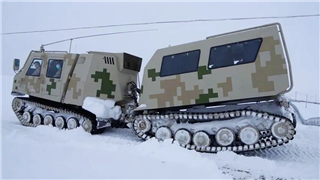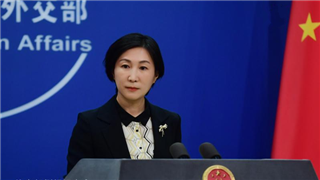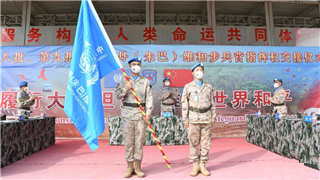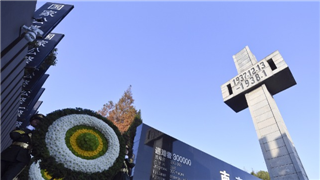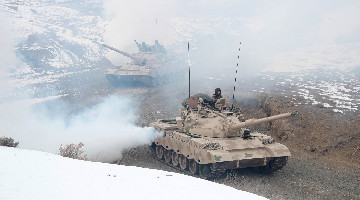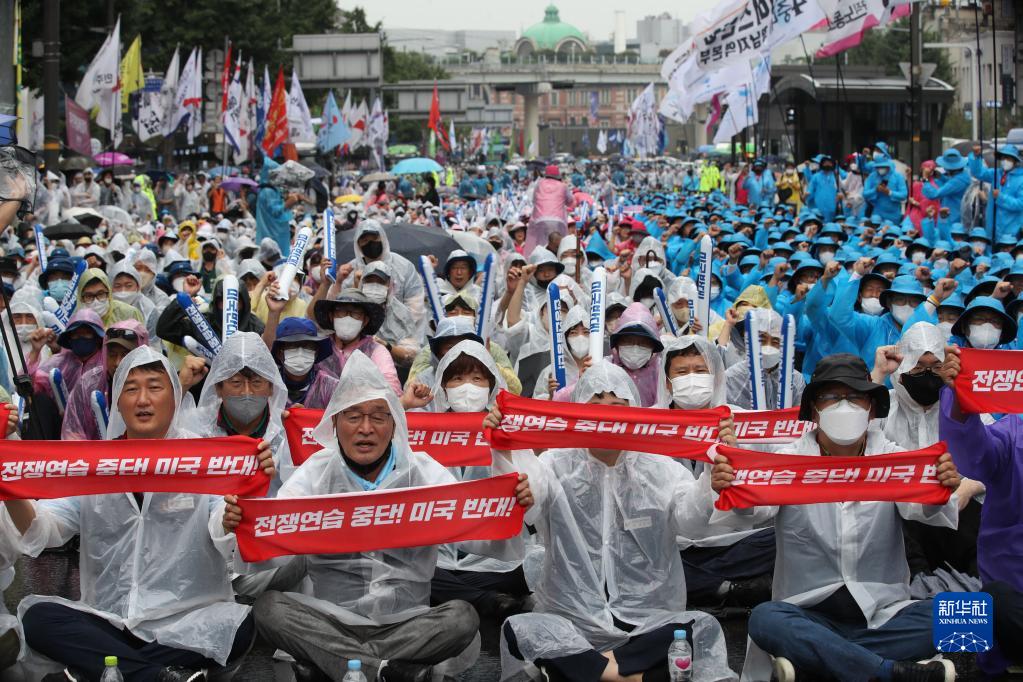
By Chen Hanghui and Qiao Changming
陈航辉 乔长铭
The US military has taken frequent moves in the Indo-Pacific Theater recently. First, the US DoD confirmed on November 1 that it will station six B-52 bombers at the Tyndall Air Force Base in Australia; then on November 22, the US Indo-Pacific Command set up a Space Force Unit to manage military space operations across the region.
近期,美军在印太战区动作频频。11月1日,美国防部证实,将在澳大利亚廷德尔空军基地部署6架B-52轰炸机;11月22日,美印太司令部率先设立战区太空军司令部,统领印太战区太空军事行动。
From redeploying military forces to setting up the new component, Americas' series of moves to reshape the military layout in the Indo-Pacific is a clear sign of its bigoted Cold War mentality.
从调整兵力部署到设立新的职能机构,美重塑印太军力布局的一系列动作,折射出其冷战思维阴魂不散。
US shifts focus eastward to make Indo-Pacific theater the new center of military deployments.
重心东移,印太战区成为军力部署新中心
Following the “Asia Pacific rebalancing” strategy in 2012, America’s National Security Strategy and National Defense Strategy released in October 2022 called China the “most consequential strategic competitor” and a “pacing challenge”. Against such a background, the US military has obviously given priority to the Indo-Pacific when deploying troops overseas, allocating elite forces and distributing advanced equipment in recent years.
美国于2012年提出“亚太再平衡”战略。2022年10月出台的美国国家安全战略和国防战略,更把中国称作“最重要的竞争者”和“步步紧逼的挑战”。在这一背景下,美军近年来在海外驻军布局、精锐力量编配和先进装备配发等方面都体现了印太优先思想。
At the moment, the Indo-Pacific theater is the new center of America’s global military deployment, commanding more than 2,000 aircraft, 200 vessels and 370,000 officers, civil personnel and contractors, as well as five of America’s 11 aircraft carriers and nearly half of the fifth-generation combat planes. Of the US military’s five overseas theaters, the Indo-Pacific theater boasts the strongest establishment, maritime and air combat capabilities, air defense and anti-missile capabilities.
目前,印太战区已成为美军全球军力部署的新中心。该战区下辖2000多架飞机、200多艘舰艇和超过37万军人、文职人员和承包商,美军11艘航母中的5艘和近一半的第五代战机都部署在印太地区,是美军5个海外战区中编制实力最强、海空作战能力最强、防空反导能力最强的战区。
The US aims to gain the upper hand through decentralized, dynamic deployments.
去中心化,妄图通过动态力量部署获取优势
While intensifying its military deployments in Indo-Pacific, the US military has adjusted its way of forward deterrence that it applied in the West Pacific during the Cold War.
在加强印太地区兵力部署的同时,美军还对冷战时期在西太平洋地区的前沿威慑存在方式进行了调整。
The US military has decentralized its Indo-Pacific deployments in an attempt to create a wide-ranging combat system that is sprawling in form but cohesive in function. That’s why it decided to relocate the nearly 10,000 marines in Okinawa to Guam, Hawaii and Australia and the two F-15C/D squadrons at Kadena Air Base to US homeland. At the same time, it has reopened, newly built or expanded military infrastructure like airports, ports and radar stations on islands along the so-called “second island chain”, and tried all means to gain the right to temporarily use military bases and important infrastructure in Southeast Asian countries and Pacific island states, with a view to weaving a resilient network of “multiple scattered” bases.
美军将“去中心化”思想引入作战体系布局,企图打造广域分布、形散神聚的印太作战体系。为此,美军决定将驻日本冲绳的近万名海军陆战队员后撤至关岛、夏威夷和澳大利亚,驻冲绳嘉手纳空军基地的2个F-15C/D中队,也将撤回美国本土。同时,在第二岛链沿线岛屿重启、新建和扩建机场、港口、雷达站等军用基础设施,并妄图以各种方式获得东南亚国家和太平洋岛国军事基地和重要基础设施的临时使用权,企图构建“多点、散布、弹性”基地网。
Setting more store by Hawaii and Guam as strategic pivots in the latest redeployment, the US military is upgrading the command, control, communication and intelligence functions at the Indo-Pacific Command headquarters in Hawaii, with a plan to make Guam the West Pacific enter of intelligence sharing, force assembly and logistics support.
在这次调整中,美军更加看重夏威夷和关岛的战略枢纽作用。美军正在升级夏威夷印太总部的指挥、控制、通信和情报功能,并有意将关岛打造成西太地区情报共享中心、兵力集结中心和后勤保障中心。
Real implementation faces many hindrances.
难以遂愿,真正落实面临诸多问题
The US seems bent on stirring up confrontation, locking China as its most consequential strategic competitor, and stepping up military preparedness in the Indo-Pacific theater. But it still faces many hindrances to putting its plans all into practice.
美执意挑动对抗,将中国锁定为首要战略竞争对手,加紧推进印太战区相关军事准备。然而,其要真正落实到位还面临诸多问题。
First of all, allies don't want to pick sides. As America pulled its troops from the so-called “first island chain” back to the safe rear area, its allies will be forced to become cannon fodder should a war really break out. Such selfishness will further erode the allies' confidence in the US-offered security protection. More important, most countries in the region hope for peaceful development and don’t want to take sides in the major country competition, much less be tied onto the American war chariot as collateral damage.
盟友不愿选边站队。美国将第一岛链美军后撤至后方安全区,意味着盟友要在战时充当炮灰,这种私心将进一步削弱盟友对美国安全保障的信心。更重要的是,大部分印太国家希望走和平发展道路,并不愿在大国竞争中选边站队,更不愿绑在美国战车上当陪葬品
Second, command and control is more difficult. Scattering its forces along a battlefront stretching thousands of kilometers makes command and control, coordination, and logistics support times more difficult. It’s hard enough to effectively command such a widely distributed force in peacetime, and things would only get worse in a wartime environment of high-intensity electromagnetic confrontation.
指挥调度更加困难。美国在长达数千公里的战线上分散部署美军,将成倍增加指挥控制、部队协同和后勤保障的难度。平时,要想有效指挥这样一支广域配置的部队都困难重重,在战时高强度电磁对抗的环境下,其指挥调度将更加困难。
Military finance is strained. By October this year, the US federal government's unpaid debt stood at around US$31.1 trillion, far more than its US$23 trillion GDP last year. The dynamic force deployments and the relaunching, construction and expansion of military infrastructure would both significantly magnify defense spending. It's uncertain whether the US military will keep up the massive input in the Indo-Pacific theater going forward.
财政支出面临挑战。截至今年10月,美国未偿联邦政府债务余额约为31.1万亿美元,大大超过美国去年全年约23万亿美元的国内生产总值。不管是推进动态兵力部署,还是重启、新建、扩建军用基础设施,都会显著增加国防开支。未来,美军能否持续维持对印太战区的高额投入,仍然需要观察。
